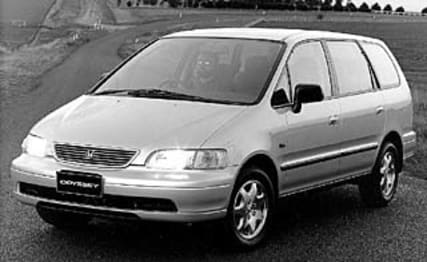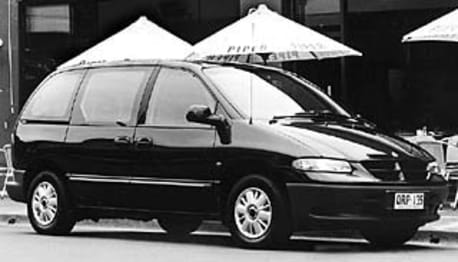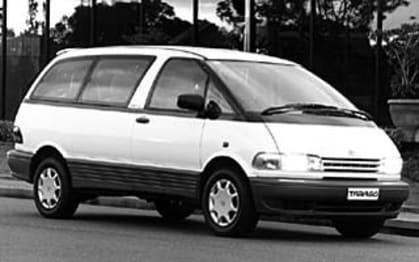
Used Honda Odyssey review: 1995-2000
- Honda Odyssey
- Honda Odyssey 1995
- Honda Odyssey 1996
- Honda Odyssey 1997
- Honda Odyssey 1998
- Honda Odyssey 1999
- Honda Odyssey 2000
- Honda Odyssey Reviews
- Honda Reviews
- Honda People mover Range
- Honda Wagon Range
- People mover
- Wagon
- Honda
- Used Car Reviews
- Buying tips
- 7 seater
Peoplemovers must be the least glamorous vehicles of any on our roads, but if you’ve got a tribe of kids there’s no better means of transport for carting them around. The good news is they aren’t the dodgy weapons they once were when most were built on the back of delivery vans.
Those early peoplemovers were the sorts of vehicles you avoided at all cost. They were unrefined, uncomfortable and had poor performance and even worse road manners. Thankfully that’s now a thing of the past and the peoplemovers of today are much better vehicles that do most things as well as regular passenger cars.
Much of that can be attributed to the Honda Odyssey, the peoplemover Honda built off the Accord platform and one of the first to bring car-like road manners and refinement to the class.
MODEL WATCH
The Odyssey was based on an Accord passenger car platform, which meant it sat lower to the road, and drove and handled much like the regular passenger car it was closely related to.
The lower stance also meant it was easier to get in and out, you didn’t have to haul yourself up to access the interior. While that’s a real plus for the Honda, it does come at a slight cost in head room.
Honda released the Odyssey in two forms, a six-seater which had a pair of ‘captains chairs’ in the middle row in 1995, and a seven-seater which substituted a bench seat for the two individual centre seats a year later.
To get into the rear seats in the six-seater it was necessary to walk between the two ‘captains chairs’, in the seven-seater you had to tilt the centre seat forward.
Once successfully seated, adults would find there was too little space to be comfortable, but let’s face it peoplemovers are mostly used to transport kids and they’d find it adequate. The location of the spare wheel, a space saver, on the side eats into the space as well.
The rear seat could also be folded into a well in the floor making a flat cargo carrying space when the seats weren’t needed for little people. It could also be reversed to make a rear facing seat ideal for picnics.
Add to that the ability to completely remove the middle two seats in the six-seater, or fold the middle seat in the seven-seater, converting the Odyssey into a two-seater van.
Power was from a 2.2-litre single overhead cam fuel-injected four-cylinder engine in those first vehicles. It was the smallest engine in the peoplemover class, but was smooth and quiet in normal circumstances, and provided adequate if not neck-snapping performance.
Power was initially 104 kW and 196 Nm, but a small increase in capacity in 1998 saw that jump to 110 kW and 209 Nm.
A smooth four-speed auto was the only transmission available.
While the Odyssey was a clever piece of packaging it was the way it drove that impressed both road testers and buyers at the time. Its ride comfort was exemplary, as was its handling and performance.
There was nothing lacking in the list of features either, the Odyssey came standard with airbags for the driver and passenger, it had dual-zone air-conditioning, ABS, power windows and mirrors, power steering, tilt column, radio cassette sound, central locking and alloy wheels.
Cruise control became standard fitment along with 13-spoke alloy wheels in March 1996, the time the seven-seater arrived.
IN THE SHOP
Very good build quality equates to a reliable run in the case of Honda generally, and that goes for the Odyssey.
The Odyssey’s power train, from engine right on through is pretty much bullet proof so there’s not much to worry about there, but it’s still worthwhile asking for a service record to verify that it has been serviced, preferably by a Honda dealer or specialist.
The size of the Honda and the difficulty in judging where the corners are means it’s worth taking a close look at the body extremities for damage, even minor, as it can be quite expensive to repair even small scars on the body coloured bumpers and side protection strips. And those scars, minor as they might be, can strip thousands of dollars from the resale price, and create doubt in the minds of potential buyers about the use a vehicle has been subjected to.
Also look carefully at the alloy wheels for damage caused by hitting kerbs, again by drivers unable to come to grips with the Odyssey’s size. If the wheels are damaged check for damage to the suspension and underbody.
Body tends to stand up well over the long term, staying tight and rattle-free, while high quality of plastics inside mean the interior also stands up well under the relentless attack of even our junior citizens.
OWNER’S SAY
Charlie Strike bought his ’98 Odyssey in 2000 with 30,000 km on the odo, and has since added another 90,000 mostly troublefree kilometres. Apart from regularly having to wheel align it, he says because of the nose-in parking in the north-west of NSW, and repairing body damage sustained in seven collisions with kangaroos he’s had no problems with it. He praises its ride comfort and fuel economy, but is critical of its flow thru ventilation, which only seems to deliver air heated by the engine.
LOOK FOR
• good resale value means a good return when you sell
• Honda build quality means few problems down the road
• good ride and handling a great leap forward for people movers
• small engine means good fuel consumption without losing much performance
• flexible interior can be used to kids or cargo
Pricing
| Year | Price From | Price To |
|---|---|---|
| 2000 | $3,850 | $8,470 |
| 1999 | $5,500 | $7,920 |
| 1998 | $5,060 | $7,700 |
| 1997 | $5,610 | $7,920 |
| 1996 | $5,610 | $7,920 |
| 1995 | $5,610 | $7,920 |
Pricing guides
Range and Specs
| Vehicle | Specs | Price* | |
|---|---|---|---|
| (6 Seat) | 2.2L, ULP, 4 SP AUTO | $5,610 – 7,920 | 1995 Honda Odyssey 1995 (6 Seat) Pricing and Specs |
Other cars to consider
$5,500
Lowest price, based on third party pricing data


























